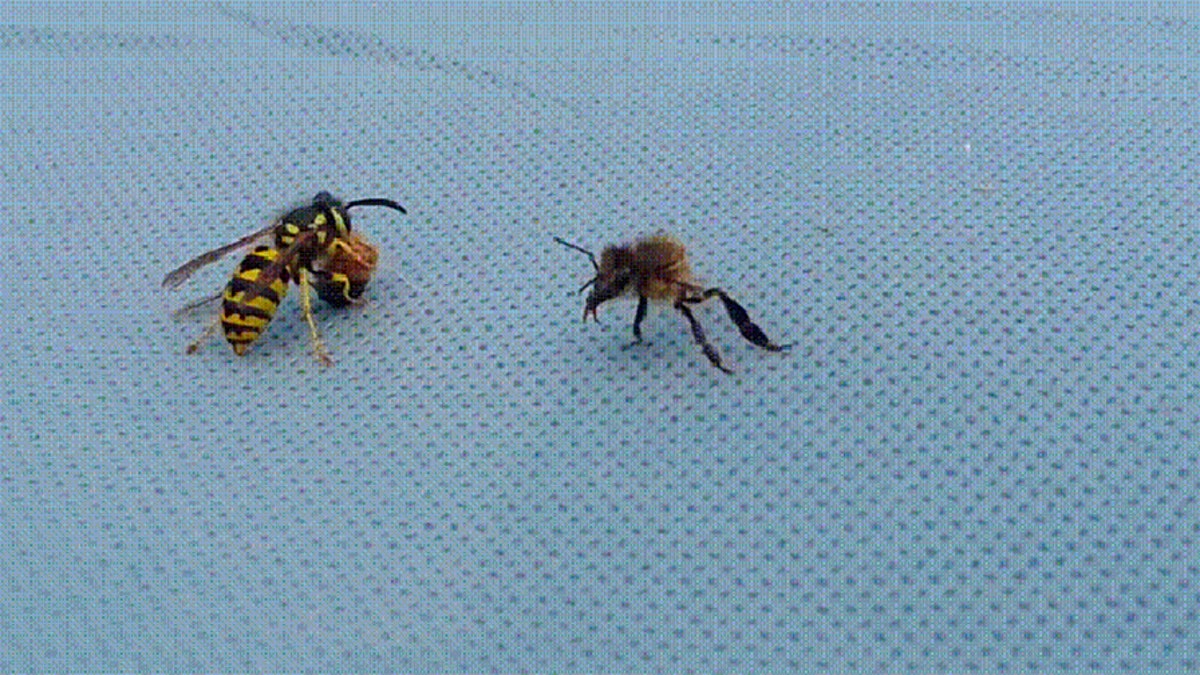
(Credit: Reddit)
Nature is red in tooth and claw — an adage that applies to the smallest creatures as well as the largest.
Just ask one unfortunate half-bee, who was gnawed in two by a yellowjacket wasp in a new video posted to Reddit by user Iamnotburgerking. The video, posted without additional detail, shows the wasp pinning down and wrestling the bee and then slicing off its abdomen. The bee slayer then flies away with the bee's rear end and leaves the hapless insect's front half scrambling.
It's gross, but not very strange behavior for yellowjackets, which take a wide range of prey, said James Carpenter, curator of Hymenoptera (the group of insects that includes wasps) at the American Museum of Natural History in New York. The field dressing of the bee isn't unusual, either, Carpenter told Live Science.
"Social wasps cut up prey to make it transportable," he said. "Indeed, sometimes they chew it up into a food ball, getting rid of the appendages." [Beastly Feasts: Amazing Photos of Animals and Their Prey]
The common name "yellowjackets" comprises a large group of predatory wasps. Their large, scissor-like jaws are made for capturing and gnawing on prey. The largest yellowjacket wasps, hornets, are the most frequent predators of bees, Carpenter said. Some species specialize in attacking beehives, he said, making bee raising (apiculture) all but impossible in those wasps' territories.
"An individual hornet can sit by the entrance to the hive, just crushing the bees," Carpenter said. Bees can sting, but hornets and other wasps have a size advantage. As such, some colonies defend themselves by mobbing the wasp attacker, Carpenter said, thus raising the wasp's body temperature and killing it via hyperthermia.
Wasps have strange interactions with other insects, as well. In 2011, researchers reported that invasive yellowjackets in New Zealand were doing something never observed before: They were picking up ants that were nosing around their food sources, flying them a few inches away and dropping them. The confused ants would rarely make it back to the food, and the wasps managed to avoid head-to-head battles with the ants, which are capable of spraying acid at attackers.
It may be tempting to root for the poor bee in the Reddit video, but Carpenter said honeybees are actually invasive species in most areas of the world, and their presence disrupts native bees. Yellowjackets, on the other hand, keep many insect pests, including flies and beetle grubs, under control, so they can be a boon for agriculture, Carpenter said.
As for the bee's frantic head in the video, it may be destined to be wasp food, too. Wasps sometimes leave part of their prey and then return for it later, Carpenter said. There is good news for the bee, though: According to research released in April, it seems unlikely that honeybees can feel pain.
Original article on Live Science.




















